Wed 2 Jul 2008
In Search of the “Big Nine”
Posted by Mike and Mindy Sontag under Tanzania
[2] Comments
THE FOLLOWING IS A GUEST BLOG BY MIKE AND MINDY SONTAG, TWO OF OUR CLOSE FRIENDS FROM NASHVILLE WHO MET US IN TANZANIA FOR A SAFARI:Â
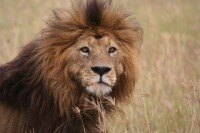
To some, the success of a game-viewing safari is measured by whether the safari-goers spotted all of the “Big Nine”: the lion, the leopard, the cheetah, the cape buffalo, the elephant, the black rhinoceros, the hippo, the zebra and the giraffe. As we made our way to the Ngorongoro Crater we had managed only six, lacking the cheetah, the black rhino and the leopard. If we were to achieve this feat, we would have only our days in the crater and the Serengeti to do so.
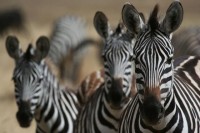
The Ngorongoro Crater is the most spectacular part of an area referred to as the “Crater Highlands,” which consists of a series of volcanic mountains and collapsed volcanoes, or calderas. The crater itself is a massive expanse of land that, at roughly fifteen miles wide, is one of the largest calderas in the world. It is an incredible sight; its steep walls create incredible blue-green vistas at every turn. The crater is also known for its massive collection of animals, with lions, cape buffaloes, wildebeest, zebras, elephants, and many, many other species roaming freely within its walls.Â
Â
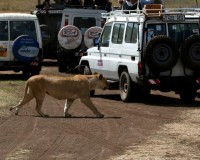
On our first morning in the crater, we all met at 6:30 am (yes, Shanna included) to get to the park before the masses had started their trek in the same direction. We were immediately greeted by the first of four separate spottings of lions, each providing its own spectacular opportunity to see these magnificent animals in their own environment. Our first viewing included two lionesses with six young cubs in tow taking full direction from their mothers. We then followed one of the lionesses as she began a hunt. We watched the zebras and wildebeests nearby snap to full alert when they sensed her presence. At one point, the lioness passed literally within a foot of our car, causing Derek to retreat with his camera from the window to the safety of the interior of the car (once again caught in stunning fashion on video by Shanna). While the viewing was awesome, we still had yet to see the remaining three members of the “Big Nine.”
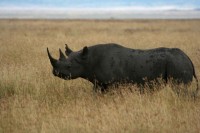
As we continued our quest, we spotted two black rhinoceroses and a baby rhino in the distance, several hundred yards from our location, followed soon thereafter by a sighting of a cheetah, also in the distance. The next day, as we were making our way around the crater, we spotted another large male rhinoceros and noticed it moving toward the Lerai Forest, the place where most of the roughly 24 rhinos in the park call home. We positioned our car between the rhino and the forest and waited as the black beast made its way toward us. After stopping to determine his path, he passed between two vehicles and within 15 yards of our car. What a truly magnificent creature–one that seems more prehistoric in its stature than most. With just the Serengeti left to visit on our safari, we had only the leopard left on our Big Nine list.
The Serengeti National Park, an immense space of over 9,173 square kilometers, is best known as the location for the annual migration of wildebeest and zebras from their “winter home” in the southern portion of the Ngorongoro Conservation Area to their northern digs in the Masai Mara (a large reserve park just over the border in Kenya). While the migration typically takes place in late May and June, the dry season came early this year and we missed seeing it, which led to a fairly disappointing first day in the Serengeti.Â
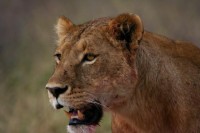
One would think that, after 12 days spent wandering from park to park, seeing God only knows how many animals of every type and taking literally thousands of pictures, we would be completely burnt out and ready for a new location, away from the dust, the heat and the land rover. You would be entirely correct. Nonetheless, as we sat around the campfire on our final evening in the bush, a most unlikely plan was hatched for our final day of viewing, especially for those who know just how much Shanna enjoys her sleep: a pre-dawn trek into the Serengeti in search of the leopard, the only remaining of the “Big Nine” that had, as of yet, escaped our now keenly trained eyes for animal viewing.Â
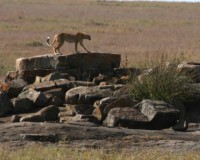
It was clear that each of us, especially those of us with the competitive juices of lawyers, wanted to achieve this seldomly met goal. As it turned out, we were rewarded in spades with what was a perfect morning of game viewing–one where we would spot eight of the “Big Nine,” lacking only a further sighting of the black rhino, which doesn’t even inhabit the Serengeti. Shortly after leaving the bush camp, we were treated to a beautiful sunrise in the Serengeti. We then spotted two jackals in the midst of a fight. Soon after Mindy snapped a requested picture of the battling pair, we all spotted a cat leaping from the shelter of taller grass, roughly 100 yards to our rear. With lightning quickness, the cat–which our guide confirmed in excited tones to be a leopard–rushed from the field on our left to the field on our right. We had seen all of the Big Nine, along with many, many others.
Â
VERY beautiful photos. I’m hoping you’ll post some of the other animals you captured in another post…..just incredible captures!!!!
Just beautiful pictures.